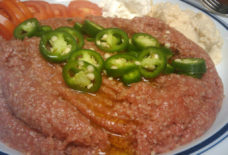Who Was the First Palestinian in Modern History?
Zachary Foster
Institute for Palestine Studies
Sporting a dark suit and fez, he always seemed to have a cigarette dangling from an ivory holder, frequently coughing “through the rings of smoke that veiled his head with fog.” His name was Khalil Baydas (1874–1949), Edward Said’s cousin once removed, and he was the first Arab to use the term “Palestinian” in the modern sense of the word.
After completing his education at the premier Russian missionary school in Nazareth—where he devoured the Russian books in the school library—Baydas worked as a principle in Russian primary schools across the region.
It was here that Baydas realized that “the people of Palestine were in need of a geography book about their country,” in his words. So at age 24 he translated the archeologist A.A. Olesnitskii’s A Description of the Holy Land from Russian to Arabic in 1898. “The current Arabic language geography books on the topic have come up short.” This book is “a description of the land of Palestine.”
The summer agricultural work in Palestine began in May with the wheat and barley harvest, Baydas explained in translation. After enduring the entire summer with no rain at all—leaving the water cisterns depleted and the rivers and springs dry—”the Palestinian peasant waits impatiently for winter to come, for the season’s rain to moisten his fossilized fields.” The modern Palestinian people were born.
[Note that this is nearly a decade and a half earlier than the last time I thought I found the first reference to the modern Palestinian people. Such is the inevitable risk of studying “firsts.”].
Recall that throughout the mid-late 19th century, American and British Protestant, French Jesuit and Russian Orthodox missionaries founded hundreds of schools across Syria and Palestine and educated tens of thousands of Arab boys and girls.
The foreign-born teachers all knew about Palestine, the word, as well as its rich history and varied geography a history and geography they taught extensively in geography and history class.
[In fact, the term Palestinian had already been used decades earlier in Western languages by the British James Finn, the German Ludwig Schneller, and the American James Wells].
Founded in 1886, the Russian Orthodox teacher’s training seminary in Nazareth, where Baydas learned Russian, played a critical role in educating a generation of Arab intellectuals who would start calling themselves Palestinian.
“Palestine during the times of Jesus,” cited in n.a., Atlas al-Kitab al-Muqaddas (Edinburgh and London- W. & A.K. Johnston, n.d.), 11.
The Early Twentieth Century
“A Palestinian describes Palestinian towns.” So read the title of a 1902 article (in Arabic) published by yet another luminary graduate of the Russian seminary, the Nazarene Orthodox Arab Salim Qub‘ayn.
In the article, Qub‘ayn compared the modern conditions of the Galilee and Tiberias to their status during the times of Jesus Christ, as described by the 19th century French scholar Ernest Renan).
This was an extremely popular genre of literature among both Orientalists in Europe as well as their Arab counterparts in the Middle East– a style pejoratively labeled as Orientalism by Edward Said.
Najib Nassar must have been inspired by the piece and sent his own thoughts on the matter to the same journal, al-Jami‘a, published by Farah Antun, the Tripolitan émigré in Egypt. (A decade later, Nassar would establish one of the most important newspapers in Palestine, al-Karmil.)
Antun turned Qub‘ayn’s article into a two-part series under the same title, “A Palestinian describes Palestinian towns.”
“While I was reading about al-Jami‘a’s coverage of the history of Jesus as explained by the philosopher Renan,” wrote Nassar, “I stumbled across the ancient names of some of Palestine’s towns.”
Nassar surveyed the ancient names of modern places in what he called Palestine. Some were mentioned in the Biblical books of Joshua and the Gospel of Mark, and others in Greek such as Herodotus and Josephus, still others by famous Arab geographers like Yaqut. It was a philological analysis of Palestine’s modern urban geography that drew its inspiration from the full gamut of ancient, Arab and modern Western sources.
Nassar, much like Qub‘ayn and his Western Orientalist counterparts, looked for the ancient, often Biblical roots of the modern place names in the Middle East.
The lands of the Bible were alive and could be examined with scrutiny to better understand the holiest and most important books in all of human history – the Old and New Testaments.
Geography and history were also essential subjects in American and French missionary schools. As the historian and archivist Christine Linder explained to me, geography was one of the five most commonly taught subjects in American missionary schools across Syria and Palestine from the 1870s to 1890s.
In fact, some of the more impressive American missionary educators, including Cornelius Van Dyck, Simeon Calhoun, George E. Post and Harvey Porter actually wrote and taught in Arabic.
Their British counterparts probably taught about Palestine using the maps depicted above, both published in London in an undated atlas probably from the late 19th or early 20th century.
Students educated primarily at the missionary schools wrote dozens of articles and books related to Palestine’s history and geography that circulated around the Middle East in the 1870s-1900s, those critical years leading up to the first appearance of the Palestinian people in world history.
They also translated various other Russian, English and French books about Palestine into Arabic. They reviewed European archaeological findings on the Palestine’s ancient history in their magazines and discussed American books about Palestine’s topography in their journals.
In turn, they popularized both the word Palestine in Arabic, which had been dormant for many centuries of Ottoman rule, while stressing the importance of its Biblical history to many thousands more in their classroom discussions, public lectures, private correspondences and dinner table conversations.
Source: blog.palestine-studies.org


